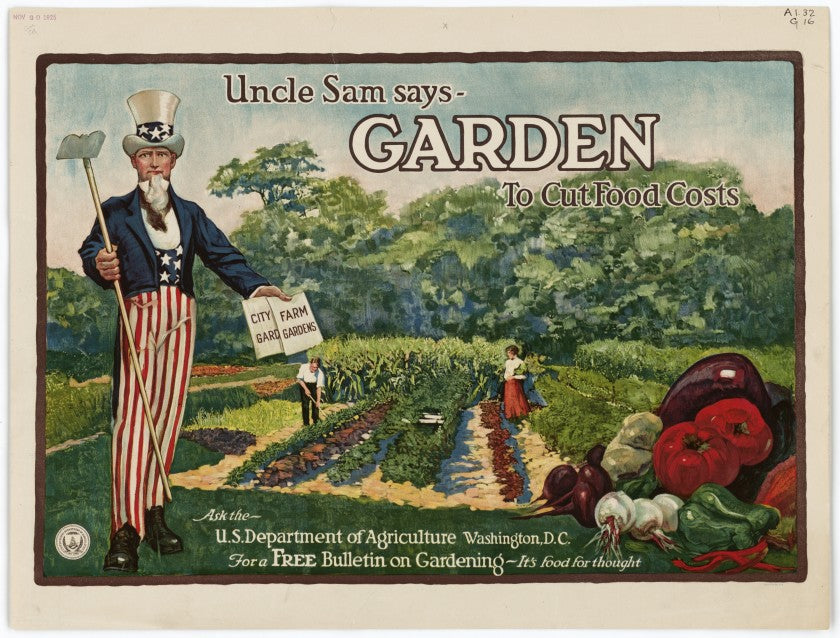
This spring, pollen isn’t the only thing floating around. Notions of Victory Gardens are also in the air, largely in response to the COVID-19 epidemic.
So what exactly is a Victory Garden? How do you grow one in your backyard? Should you do a victory dance after you’ve planted it?
For answers to these and other victory-related questions, you’ve come to the right blog.
First, a Bit of History
Victory Gardens date back to the 1940’s during World War II. While soldiers fought overseas, those back home — mainly women — responded to nationwide food shortages by planting private and public vegetable gardens. These plantings were also known as “War Gardens” and were responsible for nearly half(!!) of the produce consumed in the US.
Victory Gardens did more than boost the nutrition of those consuming the crops. They also buoyed morale and created a sense of purpose for those at home. Lawns gave way to vegetable plots. City commons sported rows of vegetables. Feelings of community, pride and hope sprouted and bloomed.
Which Brings Us to 2020
COVID-19’s side effects aren’t limited to medicine. They include uncertainty and anxiety around food shortages and access to good nutrition.
The Rx for these concerns? Growing our own food.
Just as with Victory Gardens of the past, people are gardening to help feed their families and communities while nourishing spirits during these stressful times. With many furloughed or working from home, people have more time to tend to a garden. These circumstances have created a new wave of gardeners who have never planted or are going out of their comfort zone to grow new things—including their confidence in gardening.

How to Grow A Victory Garden
If you’re new to gardening or don’t know how to create your own Victory Garden, no worries. We’re here to break it down.
Window Boxes
Live in a city? Lack space for a garden? Have windows? You’re the perfect candidate for a window box garden. Herbs, radishes, green onions, strawberries, tomatoes and peppers are all window-box friendly. Just be sure to choose dwarf and smaller varieties, such as Baby Belle Peppers or Window Box Roma Tomatoes, for the latter.
Small Space Gardens
Small spaces require big thinking. Specifically: what you’ll use your vegetables for. Sure, the idea of growing eggplant or squash might be appealing, but these varieties take up a lot of real estate and may be better purchased at the farmers’ market. For easy, staple vegetables in a small garden plot, we recommend starting with:
- Cherry Tomatoes
- Radishes
- Peppers
- Lettuce
- Herbs
- Cucumbers
- Carrots
Before you head off to the garden center, do your homework. If you go gaga for gherkins, choose a pickling variety of cucumber. If you crave cucumber on salad, select a classic Marketmore. The more research you do into spread, height, staking, sunlight, and use, the better your chance of success.
Just remember that a small plot can yield big results. When planted correctly, one raised bed can produce a large amount of food all summer long. So get ready to share.
Large Gardens
If you’re a vegetable garden pro and have ample space to create multiple raised beds or plots, we recommend planting extra to donate to your local food pantry. This isn’t just in the spirit of Victory Gardens of the past. It’s also the perfect way to give back or pay it forward during these uncertain times.
If you typically plant 6 tomato plants, consider planting 10 (if you have the bandwidth) and donate the extras to food pantries or place them in front of your home for people to take at will.
Start Slowly
There’s a Victory Garden for every need, plot and vision. Just don’t go too big too soon, which can make it hard to weed, water and harvest regularly. Instead plant a few crops and tend them carefully.
Dig In
No matter how (or where) your Victory Garden grows, you’ll enjoy creating something beautiful and becoming more self-sufficient in providing healthy food for your family and community. Bonus: gardening is proven to relieve stress, and we could all use a little more of that right now! As for that victory dance, it’s totally optional. But also might be kinda cool.
